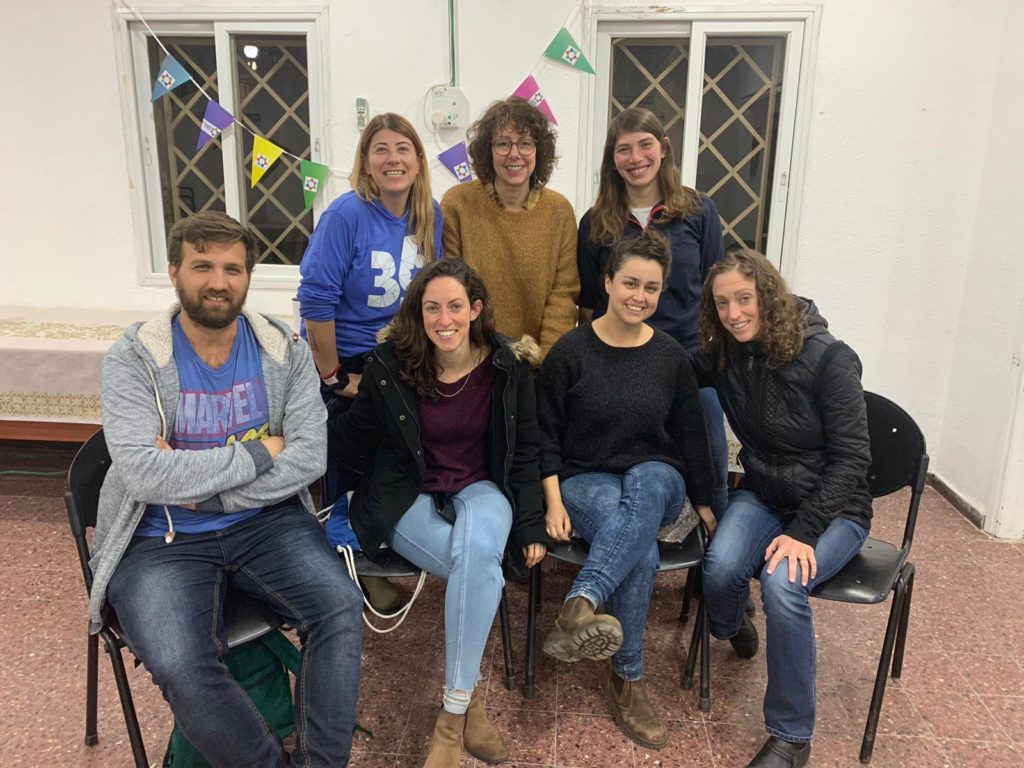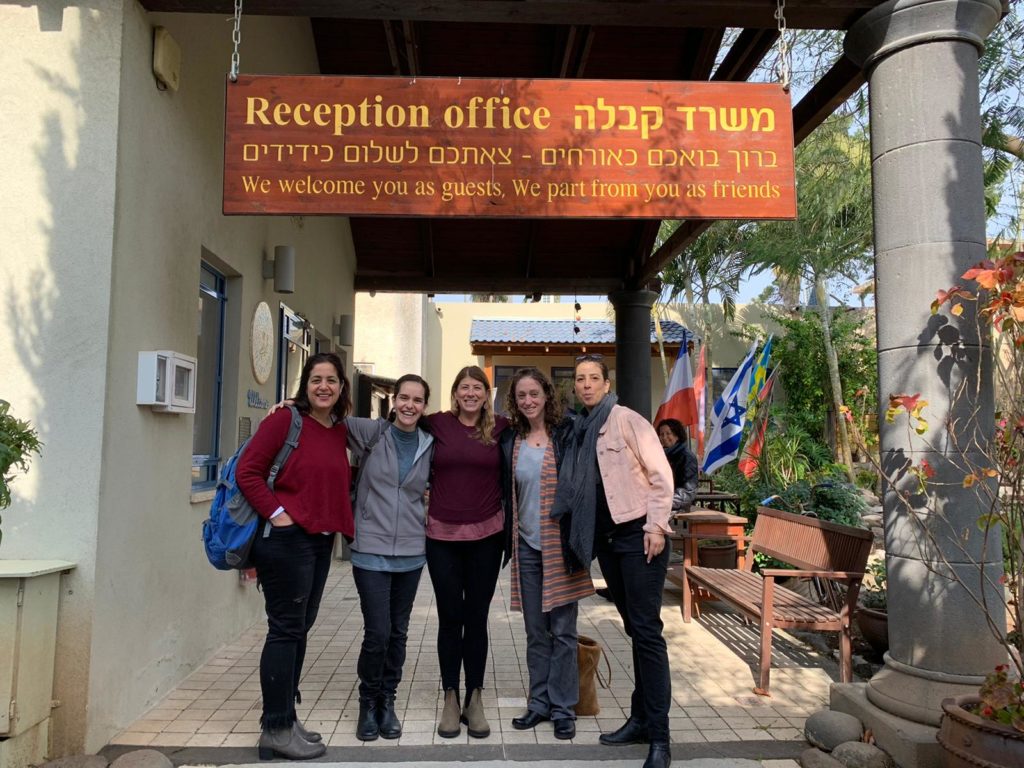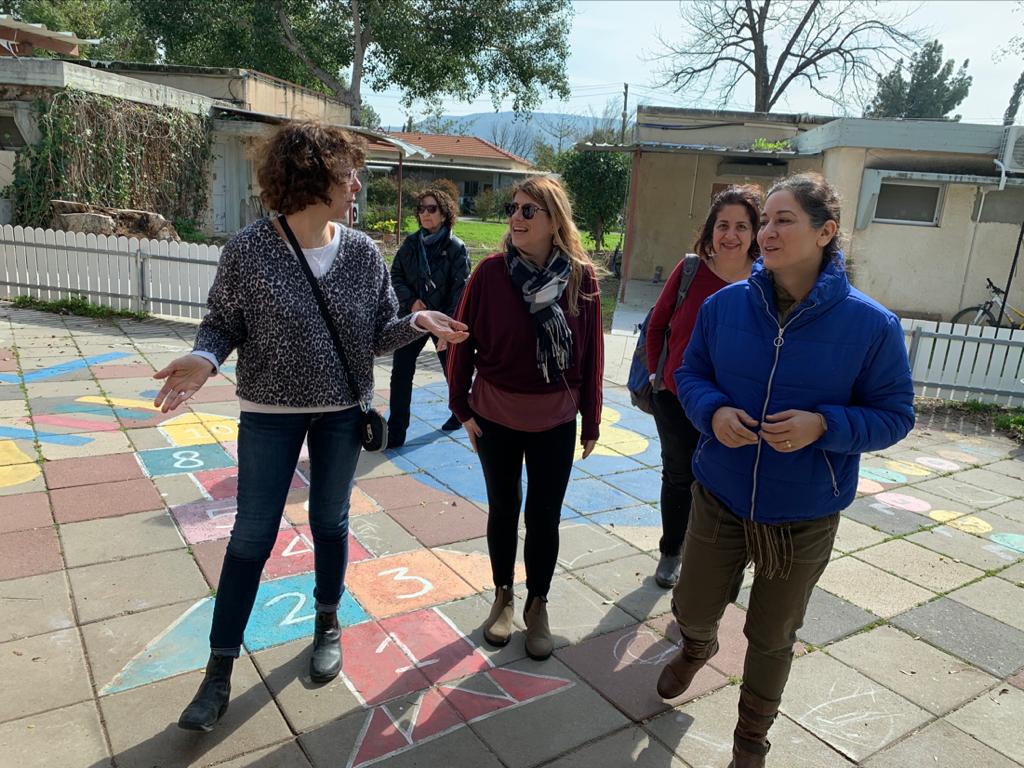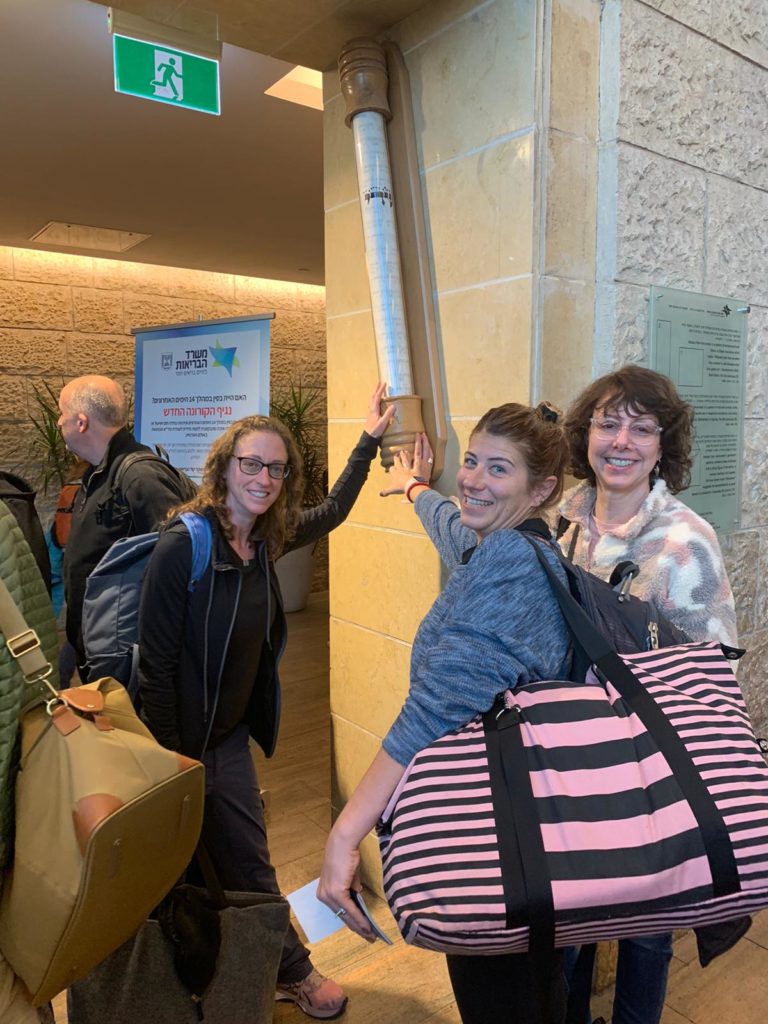P2G Educators Delegation to Israel
February 18, 2020
Written by Michelle Petrova. Taken from “A Work in Progress” Blog
The last few days have been very busy. On Sunday, we visited a variety of schools. First, we visited, Dkalim School, a school that serves cognitively impaired kids who have been treated poorly in the mainstream school. This school has about 90 kids and continues to grow. At this idyllic place, they use gardening and helping at the school to learn social and independent skills for their future lives.

Next, we visited a large kibbutz school called Mul Gilaad School, where one of our twinning teachers, Shooshi, teaches first grade. It was interesting to see the same types of activities happening at their school and ours. I also got a chance to see the bulletin board they created about Wisconsin and Sheboygan. Just like us, they celebrate the 100th day of school and the teachers create a homey environment, even allowing kids to wear slippers in class. As with most of the schools I have seen, caring for animals and growing plants and vegetables is a part of their school life. They are even training pigeons to carry messages from one area to another. The art room was so cool and the school also just built a new library which sort of combined a maker space and a library/media room.

Then, we visited the Kinneret Courtyard where the second wave of pioneers were settled and started a school to educate these new young workers about growing. We also heard a lot about important women in the beginning and throughout Israel history. I look forward to teaching about these important women soon.

Finally, we returned to the P2G office and met with a youth movement called Dror. They go into schools and teach about social justice topics. They were dedicated and passionate educators, and we are planning a joint project with them soon.
February 15, 2020
Written by Michelle Petrova. Taken from “A Work in Progress” Blog
Shabbat was so special with my teaching partner, Lee, and her family. Her extended family came over, and we had a delicious dinner. I discovered a new fruit I LOVE – pomelo. Lee also made a cheesecake with halva: what a beautiful way to combine our cultures. Her parents brought delicious food, and we ate until we could barely move. Then, I had a wonderful night of sleep.

This morning, we had a family breakfast of delicious fresh veggies and bread and homemade tahini, made by her mother. My friend from the last year’s 8th grade trip, our tour guide, Reut, came for a visit from all the way in the South, and that was so meaningful. We exchanged gifts, and she brought me olive oil made by her family. Next we all walked around her village: to a bee farm, where I bought honey for my honey, and a play area made completely from the surrounding environment. All the people from the village can come to the play ground for free, and it was packed due to the shining sun and nice weather. It was a beautiful walk surrounded by the mountains and the green.

Next, Lee’s husband, Amichai, grilled a delicious lunch for us. I am quickly learning how important food is in Israeli culture, and I need another stomach to keep up. Lee found a firefighter in her village, and he gave us a shirt for my husband too! Everyone is so nice, friendly and welcoming. Then, Reut had to head back home, but she will be in the states soon.

Our security guard, Max, is on his way now to visit, and I am very excited to have Israeli friends to visit with!! Tonight, we will eat shakshuka Lee made and she likes it how I do it, with not runny eggs. Then, we will meet up with our little group and hang out after sundown.

February 14, 2020
Written by Michelle Petrova. Taken from “A Work in Progress” Blog
Today, we toured a kibbutz in the Jordan Valley that started on March 21, 1937. We met up with people who will come to Milwaukee in April and made new friends fast. At the kibbutz, we learned all about their philosophy for learning, starting at about 8 months and continuing up to 1st grade, and thereafter their after school programs at the kibbutz. There is a 1:4 teacher to student ratio, and this is higher than the government expects from them. The kibbutz values learning through dramatic and imaginative play, building your independence, sharing and community over selfishness, and self-control, even from a very young age.

In each age group, there is a big focus on learning experiences and contentedness throughout each school year. For example, when the kids learn about winter, on their daily walk, they see how the trees change, the weather, and what you wear. The next year, they might add a level of learning by then using the alphabet to name things from winter. Then, in the classroom the students make boards together with their teachers to document and remember their learning. Students pick up stuff on their walk and use it to play and learn. They each have their own treasure bins of learning through their senses. The teachers frequently see the kids mimic the happenings of the kibbutz. When they saw a group of men fixing something, they went back to their playground and mimicked this act. They play what they see, and they learn what they play. There is also a big focus on conservation and the environment and the arts. All learning allows the kids to learn independence and self control.

My big takeaways were the fact that Ris has one child at a kibbutz school and one not, and she can see the higher level of independence her child at the kibbutz school has developed from their philosophy of learning. I have many photos and ideas to bring back to share with our lower school. I was also very impressed with how they took on the government’s new laws about inclusion of special education students. They are already doing this, despite the challenges because they see it as right for the kids.

I wondered how you joined a kibbutz and learned for theirs, they have a two year trial period, and then they must be voted in.

Afterwards, we had the best hummus lunch yet. The place had a huge relish bar and if you have ever eaten with me you know how I feel about sauces. Now, I am with my teaching partner Lee and her family getting ready for a big Shabbat dinner. Life is good, and Israel is great! Shabbat Shalom to all.
February 13, 2020
Written by Jen Saber
Today I floated between teacher and student. I got to stand at the front of the class at times and follow behind our tour guides at others. I got to answer questions from inquisitive minds and ask questions from my own wondering.

The day began with an activity to quench my thirst for knowledge. We visited Kadoorie Agricultural High School in the Lower Galilee. Kadoorie’s claim to fame is one of it’s alumni – Yizchak Rabin, fifth Prime Minister of Israel. To walk the halls of the historical first building on the campus as he had, to sit in a classroom and hear from the Principal as he may have, to look up on the wall at his class photo as he may have, was surreal. We even saw Rabin’s grades on display. As another person in my group said, “Don’t get famous or they will post your grades”. I’m thinking that’s A+ Parenting Advice to share with my children.

Stop two was the raison d’etre for my participation on the 2020 Teacher Delegation. Today was the day I visited our CEEBJ School Twin- Har Nof School.

I was tasked with the assignment to teach a lesson on Tu B’Shevat (the birthday of the trees) or Purim. What could I teach to a fifth grade class of Jewish Israelis about these holidays that they wouldn’t already know? I teach fifth grade Hebrew School and know the familiar “eyes glaze over from boredom look.” I had an a-ha moment. Doesn’t sugar maple season in Wisconsin coincide with Tu B’Shevat? Isn’t it unique to our area of the US? Yes and yes!

A public shout out to Jess at the Schlitz Audobon Center for giving me a lesson and providing me with all the real tools to walk through the steps of the process (now the Har Nof class owns two spiles) and teaching me songs (I ended up teaching a maple tree song to the tune of B-I-N-G-O). Thank you to the gift shop for stocking a Curious George book about the maple sugar process and enough pieces of maple sugar candy for the class of 26 students for taste testing.

But what meant the most to me for the 30 minutes I had with the students was not to teach them something new. It was the opportunity to bond. The opportunity to meet these students face-to-face. The opportunity to bring the School Twinning program to life – not just impersonal exchanges of packages through snail mail or videos of classroom happenings over WhatsApp. And what was the specific bonding moment? I decided I was going to teach my whole lesson in Hebrew. I am being kind when I say I am still a student of the language. If you have ever tried to have a conversation with me you know I often mime as I’m searching for a word to keep the convo flowing. During my lesson as I paused searching for a Hebrew verb or stuttered out a phrase, this classroom of young fluent Hebrew speakers quickly and gently spoke up to help me. This little mensch gesture by the students (which they probably didn’t think anything of) through my eyes was a big bonding moment. Todah Rabah (thank you).

And todah rabah to Naomi – my School Twinning partner teacher – for welcoming me into Har Nof School with open arms and sharing her classroom with me. I look forward to continuing our partnership together.

February 12, 2020
Written by Michelle Petrova. Taken from “A Work in Progress” Blog
After a wonderful night of sleep, we hit the ground running. This morning, we spent at Kadoorie learning about the school and meeting up with our teaching partners. On our way we saw many blooming almond trees, which is a nice change from the snow and cold we left behind.
This school is very unique to Israel. Students learn immersed with all the cultures of Israel, and they build their identity based on this unique philosophy. Typically in Israel, schools are separated by religion. The man who started the school, Kadoorie, believed in equality for all. Students learn about all religions and cultures represented at the school, and the staff is also multicultural.

The school is also unique because it works off of a model similar to the USA, in regard to students with autism. At Kadoorie, they have a school where lower functioning autistic students can also learn and flourish. They are also a part of the regular classes, learning with, and receiving support from, their peers. Recently, legislature in Israel has changed to move all schools in the direction of immersing students with special needs into the regular population.
Kadoorie is an agricultural school which starts in 7th grade, and for most, ends in 12th. Students can also defer the army for two years and attend the 13th and 14th grade, if they are studying engineering. Currently, there are close to 1600 students learning here. Of those, about 300 live at the school. The campus is beautiful and visiting students often comment on the fact it does not look like a school.

Next, I will participate in a lesson with my teaching partner, Lee. She is having students put together a puzzle of the USA, and then we will talk about Wisconsin. Students have many questions, and Lee even has kids who aren’t in her class joining today to learn with us. More to come tonight…

After meeting the kids, telling them about MJDS, Milwaukee, Wisconsin, and answering their questions, we headed into Tiberius.
After lunch, our first stop was the Dona Gracia Museum and Hotel. Who is Dona Gracia? The answer is a woman well before her time. She was a savvy business woman, in a time women were often silenced. She spent her life saving Jews and Christians from the Spanish Inquisition. And, she was so rich and powerful she manipulated kings into do her dirty work, which ultimately brought tons of Jews to live in Tiberius. All in all, she is the unnamed queen of the Jews and she is fascinating. I am clearly buying the book about her and reading it very soon. We also got to do a fashion show in 15th century style clothing: super fun!

Next, we walked around the city to hear about it’s fascinating history of Jews and Muslim’s living together, the many empires who have made their mark on Tiberius, and visit the Dona Gracia wall, which she financed but never saw in her lifetime.
We ended our night with a serious dinner of smoked meats, which were delicious.

We were joined by the woman who started the twinning program and a lot of teachers who have visited Milwaukee. It was a wonderful day 1, and I am learning so much. Goodnight and more tomorrow…
February 11, 2020
Written by Jen Saber
We met at the Terminal 5 food court in O’Hare. Instant friends- Michelle, Tracey and me. It was like we’ve known each other for years instead of just a few WhatsApp exchanges. Instant easy conversation over our family, our hobbies, our jobs and our love of the land of Israel. What better way to start our journey together.

Air France delivered us safely to Eretz Yisrael through Paris, France. Jewish geography, comparing pedagogical approaches and book recommendations for one another filled our time as we took a van to our home for the night at Kibbutz Lavi Hotel.
The highlight of our day’s travel was exiting baggage claim and entering the receiving area at Ben Gurion Airport. I heard Tracey exclaim, “Oh my God” while a young gal dressed in an IDF uniform ran up to hug her. Tracey’s daughter who is living in Israel made a surprise appearance.

From Tefilat Ha’Derech- The Travelers Prayer…..May it be Your will, Lord, our God and the God of our ancestors, that You lead us toward peace, guide our footsteps toward peace, and make us reach our desired destination for life, gladness, and peace. Amen.

Upon checking in at Hotel Lavi Hotel, the staff person behind the desk mentioned there would be a talk on the history of Kibbutz Lavi. Not one to miss an educational opportunity, I raced to my room, dumped my suitcase and found myself in a conference room down the hall to meet Yitzchak, a 54 year resident of Kibbutz Lavi (formerly from Chicago). Yizchak shared the history of the kibbutz movement and details about Kibbutz Lavi. When I told him I was from Wisconsin, Yizchak told me he visited Madison years ago. He was in charge of the kibbutz’s dairy and bought farming equipment in our own state capitol. Small world.

Another educational, small world moment I appreciated was the connection between where I was sitting and the front hall of the JCC in Milwaukee. Last week I went on a field trip from CEEBJ with my daughter Lexi’s class to see the exhibit “A Thousand Kisses: Stories of the Kindertransport”. This is the story of the unaccompanied Jewish children who were brought to Britain from Nazi Germany, Austria, Czechoslovakia and Poland. Many of the founders of Kibbutz Lavi were what Yitzckak called, “Kindertransport Graduates”. That, to me, was a wow moment, to be at the next stop on the timeline of that mark in Jewish history.
Today to me was about creating community. I embarked today on the P2G Teacher Delegation with Michelle and Tracey. We came together as three individuals and by the end of our 24 hour journey, joined together as one learning community. As we move through our days in the Sovev-Kinneret, we will have each other to process, brainstorm, reflect, share, learn from one another.
February 11-12, 2020
Jewish educators from Milwaukee and St. Paul are in our P2G Sovev Kinneret region this week. This educators delegation is a follow up trip to the Israeli educators delegation that came to Milwaukee in 2018.

While in Israel, P2G educators will meet their respective twinning schools (Congregation Emanu-El B’ne Jeshurun & Har Nof Tiberias; Milwaukee Jewish Day School & Kadoori; St. Paul JCC & Gan Savion), learn about the students and teachers and co-lesson plan with the goal of keeping Milwaukee, St. Paul and Israel connected in the next generation!



